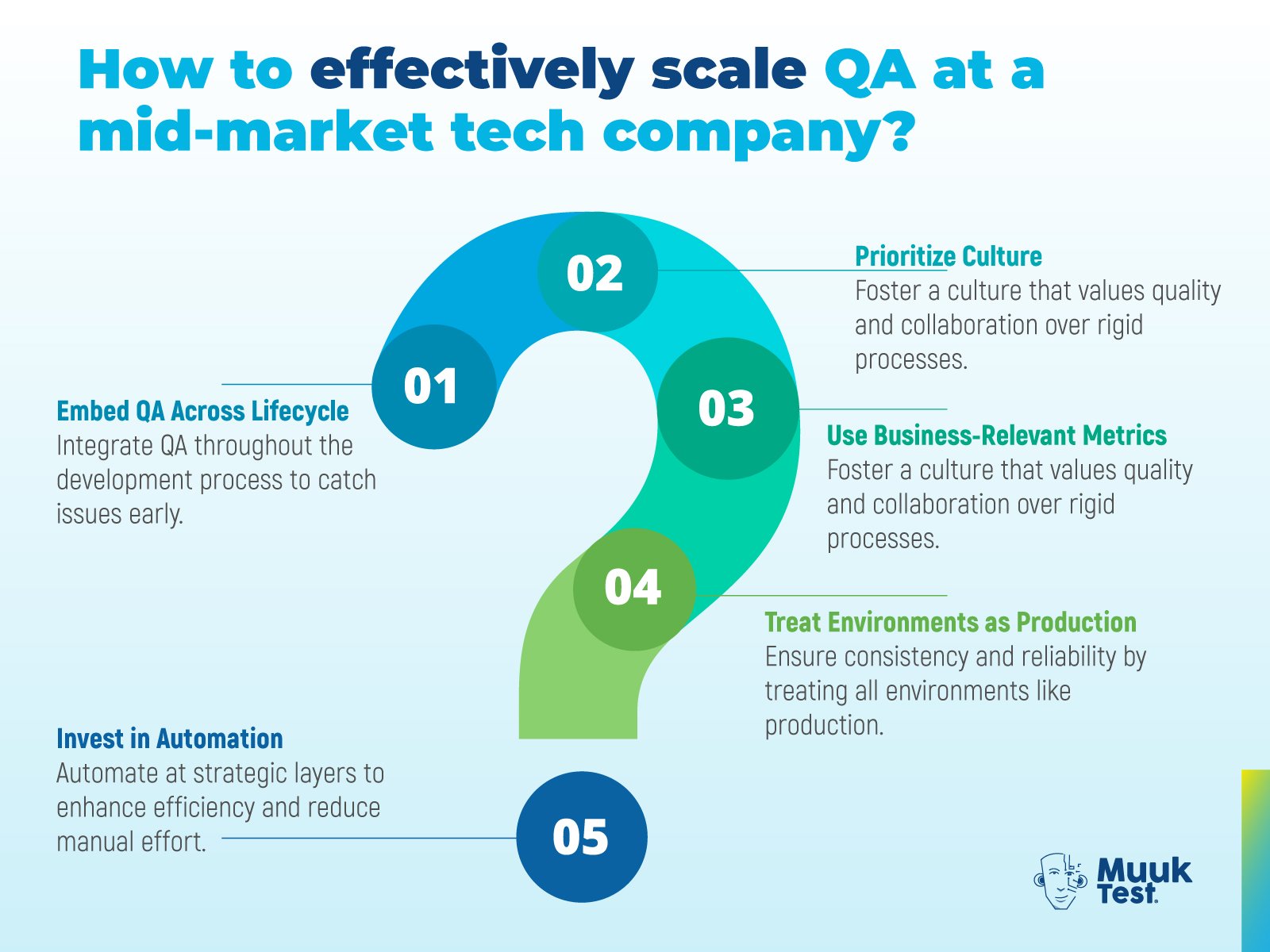-
QA debt compounds fast: Prioritize automation early and at the right layers (unit/API/critical UI). Aim for a stable suite that runs in ~30 minutes and invest in reliable test environments to avoid flakiness.
-
Make quality a shared responsibility: Embed testers in squads as quality coaches to shape acceptance criteria, pair with devs, and cut defect leakage while speeding up releases.
-
Measure what matters: Track defect leakage %, MTTR, automation ROI, and customer-reported issues/NPS to tie QA to revenue, reputation, and velocity, not vanity counts.
-
Steal proven patterns: Continuous deployment with feature flags, “quality assistance” over silos, squad ownership, and consumer-driven contract testing to catch breaking changes before production.

Running a mid-market tech company is always a challenge. Neither are they a scrappy startup, nor are they an enterprise giant. Finding the right size QA team is one of the most challenging puzzles to solve.
They are no longer small enough to just test in production and rely on quick patches, and they are not big enough to have unlimited QA teams, automation, and multi-million-dollar test budgets.
I learned this the hard way. When I look back, I can recognize so many things I wish I'd known before scaling QA in a mid-market tech company.
Most of the lessons came from the painful outages, and some came from inspiring recoveries. All of them, I believe, will help the next generation of QA leaders to avoid the same pitfalls.
Key Lessons for Scaling QA in Mid-Market Companies
History shows that scaling startups without a balanced QA strategy face higher risks of stalled growth, buggy releases, and lost customer trust. Below are three well-known examples that illustrate how different approaches to QA, too little or too much, can slow even the most promising companies.
Lesson 1: How QA Debt Slows Down Mid-Market Companies
Yes, you heard it right. QA debt is real. It’s the hidden cost of all the shortcuts that you take when testing doesn't scale as fast as your codebase. Think of it as technical debt’s cousin, but for quality.
In one of the mid-sized companies I know, they increased from 2 QA engineers working with 15 developers to 6 QA engineers working with 50 developers. On paper, that sounds like progress, but in reality, the coverage slipped, automation lagged, regressions ran into weeks, and the defect leakage climbed up to 30%.
What I wish I knew: Start Automation Early
Quality debt grows exponentially, not linearly. Once you fall behind, it's painful to catch up. Prioritize your test automation early, even if it slows you down temporarily.
Lesson 2: Test Automation is a Journey, Not a Destination
Every mid-market company aspires to achieve 100% automation. But the reality is far different from this.
In the early scaling years of HubSpot, they focused aggressively on building out automation, but soon realized that their UI tests were so brittle that they took more time to maintain than they were intended to save.
They planned to invest in API-level automation and contract testing for microservices, making them faster to run, easier to maintain, and better aligned with CI/CD pipelines.
Automation is not about coverage percentages; it's about value per test.
What I wish I knew: Measure Value per Test, not Volume
Always automate the correct layers, whether it's unit, API, or critical UI flows. Do not chase the metrics like 100% automation. A stable suite that runs in under 30 minutes is far more valuable than a bloated suite that takes 3 hours.
If you need a head start, MuukTest combines an AI testing platform with expert QAs to automate the most critical flows of your app first, helping you reach broad coverage in months, instead of years.
Lesson 3: Embedding QA as Partners in Product Development
At mid-market scale, silo kills quality. The developers keep throwing code over the wall, and product managers believe that the QA will catch everything.
One of the ways to avoid this trap is by embedding testers directly into feature squads. This gives you an advantage as they can shape acceptance criteria, identify edge cases, and pair with developers during implementation.
At one of my companies, we moved testers into cross-functional teams, and the defect leakage dropped by 40% in just two quarters. The developers began to view QA as collaborators rather than blockers.
What I wish I knew: Testers Should Think Like Product Owners
Hire testers who can think like product owners, not just bug hunters. Their role is to advocate for user experience and mitigate risk throughout the lifecycle.
Lesson 4: The Importance of Reliable Test Environments for QA
Nothing frustrates testers more than flaky environments. In mid-market companies, we often have staging servers that go down twice a week, which means the testers spend more time fixing the environments than finding bugs.
The releases slip, morale drops, and leadership wonders why QA isn't meeting its delivery expectations.
In some companies, like Netflix, they treat test environments as first-class citizens. They invested in containerization and synthetic test data, ensuring their engineers can instantly replicate production scenarios.
What I wish I knew: Budget for Stable CI/CD Early
A well-maintained staging setup with anonymized production data and stable CI-CD pipelines saves hundreds of hours of wasted testing efforts.
Lesson 5: QA Metrics That Actually Matter in Mid-Market Teams
I used to believe that metrics like “number of test cases executed” or “bugs logged” were meaningless vanity. Then I saw how the right metrics could change behavior.
At Amazon, every team tracks customer-reported defects per million transactions. At Salesforce, QA leaders measure defect removal efficiency (percentage of bugs caught before release). At one of my own companies, once we started measuring defect leakage and mean time to recovery (MTTR), leadership finally understood QA’s value in dollars saved, not just bugs found.
What I wish I knew: Align QA Metrics with Business Goals
The right metrics align QA with business outcomes. Focus on:
- Defect Leakage % (bugs that escape into production)
- Automation ROI (time saved vs. manual regression)
- Customer Satisfaction / NPS impact from bugs
If you’d like to dive deeper into which QA metrics actually matter, and which ones don’t, you can check out our detailed guide on QA metrics in software testing.
Lesson 6: Building a QA-First Culture From Leadership Down
No matter how skilled your QA team is, if top management doesn’t champion quality, shortcuts will inevitably take over.
Take Tesla as a case in point. After those early Autopilot accidents, they realized just how critical quality was to their reputation and customer trust. In response, they completely restructured their QA approach.
They began running new features in a “shadow mode” in production, allowing them to silently test functionality before fully rolling it out. This not only reinforced the Tesla brand as a quality leader but also ensured that customers ultimately benefited from reliable updates, enhancing the value of their investment in a Tesla car.
What I wish I knew: Storytelling is Part of Leadership
As a QA or Engineering leader, part of your job is storytelling. You need to make a business case for quality and demonstrate how it protects revenue, fosters customer trust, and enhances brand equity.
Real-World Lessons in Scaling QA at Tech Companies
-
Etsy – From Slow Test Suites to Continuous Deployment
Etsy once struggled with slow, monolithic test suites that blocked deployments. They adopted continuous deployment with feature flags and focused on contract testing for services. The result: deployments increased from weekly to 50+ per day without an increase in defects.
-
Atlassian – Evolving QA Into Shared Responsibility
Atlassian famously removed its dedicated QA department, shifting responsibility to developers. Instead of chaos, they invested heavily in automation, monitoring, and observability. QA didn’t disappear — it evolved into a shared responsibility supported by tooling.
-
Spotify – Empowering Developers Through the Squad Model
Spotify embedded QA roles within their squads but empowered developers to own testing. Testers became quality coaches. This hybrid approach kept velocity high while ensuring coverage.
-
My SaaS Story – How Contract Testing Prevented Outages
We had a major outage when an API update broke backward compatibility. The lack of contract tests meant no one noticed until customers did. Afterward, we implemented consumer-driven contract testing (Pact), which prevented three similar issues in the following year.
Final Thoughts on QA for Mid-Market Tech Companies
Scaling QA at a mid-market tech company is not about copying enterprises or clinging to startup habits. It’s about finding the sweet spot — lightweight enough to move fast, but rigorous enough to protect customer trust.
If I could go back, here’s what I’d tell myself:
Because at the end of the day, customers don’t remember how many test cases you executed. They remember whether your product worked when they needed it most.

Frequently Asked Questions
Why is scaling QA such a challenge for mid-market tech companies?
Mid-market companies sit in a tricky middle ground, too large to rely on ad-hoc testing like startups, but without the budget or QA headcount of enterprises. As teams grow, QA debt, flaky environments, and brittle automation often slow down releases. The key is finding a balance between speed and quality.
What is QA debt, and why does it matter when scaling?
QA debt is the cost of shortcuts in testing, such as skipping automation, relying too heavily on manual regression, or neglecting environmental stability. It grows faster than the codebase and eventually becomes expensive to fix. Starting test automation early helps reduce QA debt before it spirals.
How can tools like MuukTest help with scaling QA?
Scaling QA often takes years if you rely solely on in-house building automation. MuukTest combines an AI-powered automation platform with expert QA engineers so that mid-market companies can achieve broad test coverage in months instead of years. This reduces QA bottlenecks, allowing teams to ship faster without sacrificing reliability.
How can embedding QA into squads improve quality?
Quality builds customer trust, and trust drives growth. A strong QA strategy reduces production bugs, prevents customer churn, and improves release velocity, all critical for scaling startups.




%20(1).png?width=150&height=69&name=MuukTest-logo---light-background%20(3)%20(1).png)


